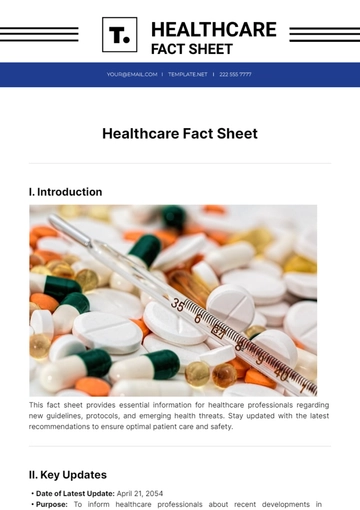Free Medical Protocol Brief

Prepared by: [Your Name]
Company: [Your Company Name]
Introduction:
The following document is an exhaustive guide to the protocols, procedures, and guidelines within the medical field. It provides a universal solution to ensure standardized practices across different medical scenarios and is meant to serve as a reference point for medical professionals at all levels from various backgrounds.
Clinical Standards and Protocols:
Clinical Standards and Protocols form the backbone of any functioning medical institution. They ensure uniformity, safety, and efficiency. Below are some general clinical standards - deviations may vary as per specialization.
Standard Procedure for Patient Admission
Standard Procedure for Patient Discharge
Standard Procedure for Surgery and Procedure Clearance
Standard Procedure for Emergency Response
Standard Procedure for Medication Administration
Hygiene and Safety Protocol:
In an environment where diseases and infections are dominant, maintaining hygiene and safety is paramount. Medical professionals should follow these steps:
Steps | Description |
|---|---|
Hand Hygiene | Hands should be cleaned using soap and water or a hand sanitizer, especially before and after handling patients. |
Use of PPEs | Personal Protective Equipment like gloves, aprons, and masks should be used appropriately and disposed of responsibly. |
Surface Cleaning | All surfaces and equipment should regularly be disinfected. |
Waste Disposal | Biohazardous waste should be disposed of in designated containers and transported for incineration or disposal by other approved methods. |
Infection Control Team | A team should be dedicated to infection control, and trained in prevailing standards and protocols. |
Ethical and Legal Guidelines:
Medical professionals are bound by a set of ethical principles and legal guidelines that underscore their practice. These standards are designed to protect patients, and medical professionals and enhance the reputation of the medical profession.
Ethical principles include:
Respect for Autonomy: respecting the individual's capacity for self-determination.
Beneficence: acting in the best interests of the patients.
Non-maleficence: causing no harm, intentionally or unintentionally.
Justice: treating all individuals equally, and distributing resources equitably.
Conclusion:
This document provides a concise and comprehensive guide to medical protocols, procedures and guidelines. It is advised that every healthcare professional takes time to understand and apply these instructions correctly and consistently. We at [YOUR COMPANY NAME] are committed to providing a high standard of care and maintaining patient trust.
- 100% Customizable, free editor
- Access 1 Million+ Templates, photo’s & graphics
- Download or share as a template
- Click and replace photos, graphics, text, backgrounds
- Resize, crop, AI write & more
- Access advanced editor
Introducing the Medical Protocol Brief Template from Template.net - your ultimate solution for precise medical documentation. Crafted for efficiency, it's not just editable but fully customizable to suit your unique needs. Seamlessly integrate vital information with ease. What's more, it's editable in our AI Editor too, ensuring effortless updates. Streamline your medical protocols effortlessly with this versatile template.





























